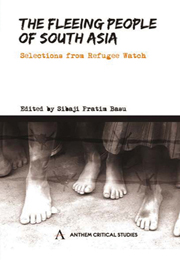Book contents
- Frontmatter
- Contents
- Acronyms and Abbreviations
- Foreword by Ranabir Samaddar
- Preface
- ETHICAL ISSUES
- LAWS
- SOUTH ASIA
- INDIA
- Introduction
- Population Displacement in India: A Critical Overview
- Reporting from Gagan Geer: A Kargil War Refugee Camp
- Barricaded Kashmiri Pandits Letting Go the Right to Return?
- Homeless and Divided in Jammu and Kashmir
- Internal Displacement in North-East India: Challenges Ahead
- The North-East Today: Displacing Identities, Displaced Identities
- Tibetan Refugees in India: Surviving in Exile
- Unrest and Displacement: Rajbanshis in North Bengal
- Adivasis in Coal Mining
- GENDER
- INTERVIEW/CORRESPONDENCE
- REPRESENTATIONS
- Index
Unrest and Displacement: Rajbanshis in North Bengal
from INDIA
Published online by Cambridge University Press: 05 March 2012
- Frontmatter
- Contents
- Acronyms and Abbreviations
- Foreword by Ranabir Samaddar
- Preface
- ETHICAL ISSUES
- LAWS
- SOUTH ASIA
- INDIA
- Introduction
- Population Displacement in India: A Critical Overview
- Reporting from Gagan Geer: A Kargil War Refugee Camp
- Barricaded Kashmiri Pandits Letting Go the Right to Return?
- Homeless and Divided in Jammu and Kashmir
- Internal Displacement in North-East India: Challenges Ahead
- The North-East Today: Displacing Identities, Displaced Identities
- Tibetan Refugees in India: Surviving in Exile
- Unrest and Displacement: Rajbanshis in North Bengal
- Adivasis in Coal Mining
- GENDER
- INTERVIEW/CORRESPONDENCE
- REPRESENTATIONS
- Index
Summary
Since independence, India has followed a development policy based on large-scale creation of infrastructure and industries, all of which required acquisition of land. As it happens, a large part of our natural resources lie in the hilly and forest areas, mostly inhabited by tribals and backward castes – some of the most disadvantaged sections of the population. Following past colonial practice, land has been acquired in exercise of the principle of ‘eminent domain’, which confers upon the government the power to take over private property for public purpose. Thus, involuntary resettlement has been the unintended companion of development. […]
Displacement for marginal communities is a catastrophe: it disrupts an entire way of life. It involves a trauma, which can never be fully compensated in economic terms. This realization, along with the fact that they did not share in the fruits of the sacrifices they were called to make in the name of the nation, increase the sense of alienation of these marginalized victims of land dispossession giving rise to protest movements, holding up the development process, causing destruction to life and property and generally imposing an efficiency cost on the system.
This chapter traces the genesis of one such mass movement in the districts of North Bengal, led by the Kamtapuri People's Party (KPP) demanding a separate state of Kamtapur. The Kamtapuri movement, which has seen a recent upsurge in the Jalpaiguri, Dhupguri, Cooch Bihar, Naxalbari, Fasidewa and other neighbouring districts of North Bengal, is an ultimate outcome of the struggle for power and the associated privileges between the indigenous communities (particularly the Koch/Rajbanshi's) and the Bengali and Marwari immigrants.
- Type
- Chapter
- Information
- The Fleeing People of South AsiaSelections from Refugee Watch, pp. 274 - 282Publisher: Anthem PressPrint publication year: 2009



